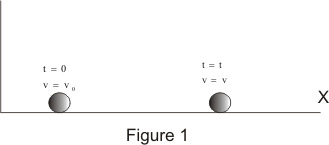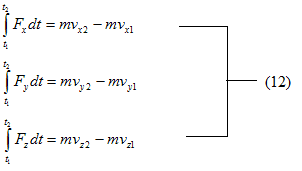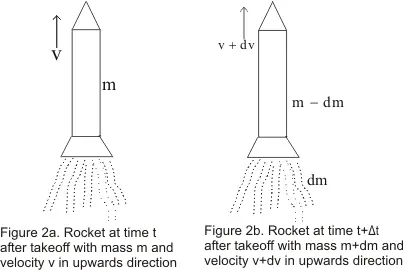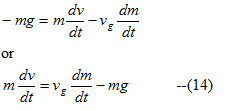Impulse and Linear Momentum
(1) Introduction
- We have already studied about the newton's laws of motion and about their application
- It becomes difficult to use Newton's law of motion as it is while studying complex problems like collision of two objects,motion of the molecules of the gas,rocket propulsion system etc
- Thus a further study of newton's law is required to find some theorem or principles which are direct consequences of Newton's law
- We have already studied one such principle which is principle of conservation of energy.Here in this chapter we will define momentum and learn about the principle of conservation of momentum .
- Thus we begin this chapter with the concept of impluse and momentum which like work and energy are developed from Newton's law of motion
(2) Impulse and momentum
- To explain the terms impulse and momentum consider a particle of mass m is moving along x-axis under the action of constant force F as shown below in the figure

- If at time t=0 ,velocity of the particle is v0 then at any time t velocity of particle is given by the equation
v = v0 + at
where a = F/m
can be determined from the newton's second law of motion .Putting value of acceleration in above equation\
we get
mv = mv0 + Ft
or
Ft = mv - mv0 -(1) - right side of the equation Ft, is the product of force and the time during which the force acts and is known as the impluse
Thus
Impulse= Ft - If a constant force acts on a body during a time from t1 and t2,then impulse of the force is
I = F(t2-t1) -(2)
Thus impulse recieved during an impact is defined as the product of the force and time interval during which it acts - Again consider left hand side of the equation (1) which is the difference of the product of mass and velocity of the particle at two different times t=0 and t=t
- This product of mass and velocity is known as linear momentum and is represented by the symbol p. Mathematically
p = mv --(3) - physically equation (1) states that the impulse of force from time t=0 to t=t is equal to the change in linear momentum during
- If at time t1 velocity of the particle is v1 and at time t2 velocity of the particle is v2,then
F(t2-t1)=mv2-mv1 -(4) - so far we have considered the case of the particle moving in a straight line i.e along x-axis and quantities involved F,v, and a were all scalars
- If we call these quantities as components of the vectors F,v and a along x-axis and generalize the definations of momentum and impulse so that the motion now is not constrained along one -direction ,Thus we got
Impulse=I=F(t2-t1) -(5)
Linear momentum=p=mv -(6)
where
I=Ixi+Iyj+Izk
F=Fxi+Fyj+Fzk
p=pxi+pyj+pzk
v=vxi+vyj+vzk
are expressed in terms of their components along x,y and z axis and also in terms of unit vectors - On generalizing equation (4) using respective vectors quantities we get the equation
F(t2-t1) =mv2-mv1 -(7) - So far while discussing Impulse and momentum we have considered force acting on particle is constant in direction and maagnitude
- In general ,the magnitude of the force may vary with time or both the direction and magnitude may vary with time
- Consider a particle of mass m moving in a three-dimensional space and is acted upon by the varying resultant force F. Now from newtons second law of motion we know that
F=m(dv/dt)
or Fdt=mdv - If at time t1 velocity of the particle is v1 and at time t2 velocity of the particle is v2,then from above equation we have

- Integral on the left hand side of the equation (8) is the impulse of the force F in the time interval (t2-t1) and is a vector quantity,Thus

Above integral can be calculated easily if the Force F is some known function of time t i.e.,
F=F(t) - Integral on the right side is when evaluated gives the product of the mass of the particle and change in the velocity of the partcile

- using equation (9) and (10) to rewrite the equation (8) we get

- Equivalent equations of equation (11) for particle moving in space are

- Thus we conclude that impulse of force F during the time interval t2-t1 is equal to the change in the linear momentum of the body on which its acts
- SI units of impulse is Ns or Kgms-1
(3) Conservation of Linear momentum
- Law of conservation of linear momentum is a extremely important consequence of Newton's third law of motion in combination with the second law of motion
- Consider two particles of mass m1 and m2 interacting with each other and forces acting on these particles are only the ones they exert on each other.
- Let F12 be the force exerted by the particle 2 on particle 1 having mass m1 and velocity v1 and F21=-F12 be the force exerted by the particle 1 on particle 2 having mass m2 and velocity v2
- Applying newton second law of each particle on each partcile
F12=m1(dv1/dt)
and F21=m2(dv2/dt) - from newton's third law of motion
F21=-F12
or m1(dv1/dt) + m2(dv2/dt)=0
Since mass of the particles are not varying with time so we can write
(d/dt)(m1v1 +m2v2)=0
or m1v1 +m2v2=constant --(13) - we have already defined the quantity mv as the momentum of the particle
- Thus we conclude that when two particles are subjected only to their mutual interactions ,the sum of the momentums of the bodies remains constant in time or we can say the total momentum of the two particles does not change becuase of the any mutual interactions between them
- For any kind of force between two particles then sum of the momentum ,both before and after the action of force should be equal i.e total momentum remains constant
- We thus arrive to the statment of principle of conservation of linear momentum
" when no resultant external force acts on system ,the total momentum of the system remains constant in magnitude and direction" - In absence of external forces for a number of interacting particles,law of conservation of linear momentum can be expressed as
m1v1 +m2v2+m3v3+m4v4+...=constant - Law of conservation of linear momentum is one of the most fundamental and important principle of mechanics
- This principle also holds true even if the forces between the interacting particles is not conservative
- Once again ,the total momentum of two or any number of particles of interacting particles is constant if they are isolated
from outside influences (or no resultant external forces is acting on the particles)
(4) Recoil of a gun
- Consider the gun and bullet in its barrel as an isolated system
- In the begining when bullet is not fired both the gun and bullet are at rest.So the momentum of the before firing is zero
pi=0 - Now when the bullet is fired ,it moves in the forward direction and gun recoil back in the opposite direction
- Let mb be the mass and vb of velocity of the bullet And mg and vg be the velcoity of the gun after the firing
- Total momentum of the system after the firing would be
pf=mbvb +mgvg - since no external force are acting on the system,we can apply the law of conservation of linear momentum to the system
Therfore
pf=pi
or mbvb +mgvg=0
or vg=-(mbvb/mg)
- The negative sign in above equation shows that velocity of the recoil of gun is opposite to the velocity of the bullet
- Since mass of the gun is very large as compared to the mass of the bullet,the velocity of the recoil is very small as compared to the velocity of the bullet
(5) Motion of the system with varying mass(Rocket)
- Uptill now while studying classical mechanics we have always considered the particle under consideration to have constant mas
- Some times it is required to deal with the particles or system of particles in which mass is varying and motion of the rocket is one such examples
- In a rocket fuel is burned and the exhaust gas is expelled out from the rear of the rocket
- The force exerted by the exhaust gas on the rocket is equal and opposite to the force exerted by the rocket to expell it
- This force exerted by the exhaust gas on the rocket propels the rocket forwards
- The more gass is ejected from the rocket ,the mass of the rcoket decreases

- To analyze this process let us consider a rocket being fired in upwards direction and we neglect the resistance offered by the air to the motion of the rocket and variation in the value of the acceleration due to gravity with height
- Figure above shows a rocket of mass m at a time t after its take off moving with velocity v.Thus at time t momentum of the rocket is equal to mv.THus
pi=mv - Now after a short interval of time dt,gas of total mass dm is ejected from the rocket
- If vg represents the downward speed of the gas relative to the rocket then velocity of the gas relative to earth is
vge=v-vg
And its momentum equal to
dmvge=dm(v-vg) - At time t+dt,the rocket and unburned fuel has mass m-dm and its moves with the speed v+dv.Thus momentum of thee rocket is
=(m-dm)(v+dv)
- Total momentum of the system at time t+dt is
pf=dm(v-vg)+(m-dm)(v+dv)
Here system constitute the ejected gas and rocket at the time t+dt - From Impulse momentum relation we know that change in momentum of the system is equal to the product of the resultant external force acting on the system and the time interval during which the force acts
- Here external force on the rocket is weight -mg of the rocket ( the upward direction is taken as positive)
- Now
Impulse=change in momentum
Fextdt=pf-pi
or
-mgdt=dm(v-vg)+(m-dm)(v+dv) - mv
or
-mgdt=mdv-vgdm-dmdv
term dmdv can be dropped as this product is neglibigle in comparison of other two terms
Thus we have
- In equation (14) dv/dt represent the acceleration of the rocket ,so mdv/dt =resulant force on the rocket
Therefore
Resultant Force on rocket=Upthrust on the rocket - weight of the rocket
where upthrust on rocket=vg (dm/dt) - The upthrust on rocket is proportional to both the relative velocity (vg) of the ejected gas and the mass of the gas ejected per unit time (dm/dt)
- Again from equation (14)

As rocket goes higher and higher ,value of the acceleration due to gravity g decreases continously .The values of vg and dm/dt parctically remains constant while fuel is being consumed but remaining mass m decreases continously .This result in continous increase in acceleration of rocket untill all the fuel is burned up - Now we will find the relation between the velocity at any time t and remaining mass.Again from equation (15) we have
dv=vg (dm/m) -gdt - Here dm is a +ve quantity representing mass ejected in time dt.So change in mass of the rocket in time dt is -dm.So while calculating total mass change in rocket,we must change the sign of the term containing dm
dv=-vg (dm/m) -gdt --(16) - Initially at time t=0 if the mass and velocity of the rocket are m0 and v0 respectively.After time t if m and v are mass and velocity of the rocket then integrating equation (16) within these limits

On evaluating this integral we get
v-v0=-vg(ln m- ln m0)-g(t-0)
or v=v0+vgln(m0/m) -gt (17) - equation(17) gives the change in velocity of the rocket in terms of exhaust speed and ration of initial amd final masses at any time t
- The speed acquired by the rocket when the whole of the fuel is burned out is called burn-out speed of the rocket
Solved examples
Question 1 .A 1 kg ball moving at 12 m/s collides head on with 2 kg ball moving with 24 m/s in opposite direction.What are the velocities after collision if e=2/3?
a. v1=-28 m/s,v2=-4 m/s
b. v1=-4 m/s,v2=-28 m/s
c. v1=28 m/s,v2=4 m/s
d. v1=4 m/s,v2=28 m/s
Solution 1
Let v1 and v2 be the final velocities of the mass
Since the linear momentum is conserved in the collision
Momentum before =Momentum after
1*12+2*-24=1*v1+2*v2
Which becomes
-36=v1+2v2 ----1
Now
e=(v2 -v1)/(u1 -u2)
or 2/3= (v2 -v1)/[12-(-24)]
or
v2 -v1=24 ----2
Solving 1 and 2
v2=-4
v1=-28
Hence a is correct
Question 2.A moving bullet hits a solid target resting on a frictionless surface and get embeded in it.What is conserved in it?
a. Momentum Alone
b KE alone
c. Both Momentum and KE
d. Neither KE nor momentum
Solution 2 Since no external force is present,Momentum is conserved in the collision
Since the collison is in elastic ,KE is not conserved
Question 3. A stationary body of mass 3 kg explodes into three equal parts.Two of the pieces fly off at right angles to each other with the velocities 2i m/s and 3j m/s.If the explosion takes place in 10-3 sec.find out the average force action on the third piece in N
a.(-2i-3j)103
b. (2i+3j)103
c (2i-3j)10-3
d. none of these
Solution 3.
Net momentum before explosion zero
Since momentum is conserved in explosion
Net momentum after collosion is zero
Momentum of first part after explosion=2i
Momentum of second part after explosion=3j
So momentum of third part after explosion=-(2i+3j) as net momentum is zero
Now Net change is momentum of this part =-(2i+3j)
Now we know that
Average force X time =Net change in momentum
Average force=-(2i+3j) 103
hence a is correct
Question 4.A bullet of mass m is fired horizontally with a velocity u on a wooden block of Mass M suspended from a support and get embeded into it.The KE of th wooden + block system after the collisson
a.m2u2/2(M+m)
b.mu2/2
c. (m+M)u2/2
d. mMu2/2(M+m)
b>Solution 4.
Intial velocity of bullet=u
Intial velocity of block=0
So net momentum before collison=mu
Let v be the velocity after collision
Then Net momentum after collision=(M+m)v
Now linear momentum is conserved in this collision
so
mu=(M+m)v
or v=mu/(M+m)
So kinetic energy after collision
=(1/2)m2u2/2(M+m)
Hence a is correct
Question 5.A body of Mass M and having momentum p is moving on rough horizontal surface.If it is stopped in distance s.Find the value of coefficient of friction
a.p2/2M2gs
b. p/2Mgs
c. p2/2Mgs
d. p/2M2gs
Solution 5.
Deceleration due to friction=μg
Intial velocity=P/M
Now v2=u2 -2as
as v=0
P2/M2=2μgs
or μ=P2/2gsM2
Hence a is correct
Question 6.A rockets works on the principle of conservation of
a. Linear momentum
b.mass
c.energy
d. angular momentum
Solution 6. A rocket works on the principle of linear momentum.
Question 7.A flat car of weight W roll without resistance along on a horizontal track .Intially the car together with weight w is moving to the right with speed v.What invcrement of the velocity car will obtain if man runs with speed u reltaive to the floor of the car and jumps of at the left?
a.wu/w+W
b. Wu/W+w
c. (W+w)u/w
d. none of the above
Solution 7 Considering velocities to the right as positive
The intial momentum of the system is
=[(W+w)/g]v
Let Δv be the increment in velocity then
Final momentun of the car is
(W/g)(v+Δv)
While that of man is
(w/g)(v+Δv-v)
Since no external forces act on the system,the law of conservation of momentum gives then
[(W+w)/g]v=(W/g)(v+Δv)+(w/g)(v+Δv-v
or Δv=wu/(W+w)
Question 8.Consider the following two statements.
STATEMENT 1 Linear momentum of a system of particles is zero.
STATEMENT 2 Kinetic energy of system of particles is zero.
(A) A does not imply B and B does not imply A.
(B) A implies B but B does not imply A
(C) A does not imply B but b implies A’
(D) A implies B and B implies A.
Solution 8
Net momentum=m1v1+m2v2
Net Kinectic Energy=(1/2)m1v12+(1/2)m2v22
Let v1=v ,v2=-v and m1=m2=m
Then Net momentum=0 but Net Kinectic Energy is not equal to zero
Now lets v1= v2=0
Then Net Kinectic Energy=0 and Net momentum=0
Hence (c) is correct
Question 1 .A 1 kg ball moving at 12 m/s collides head on with 2 kg ball moving with 24 m/s in opposite direction.What are the velocities after collision if e=2/3?
a. v1=-28 m/s,v2=-4 m/s
b. v1=-4 m/s,v2=-28 m/s
c. v1=28 m/s,v2=4 m/s
d. v1=4 m/s,v2=28 m/s
Solution 1
Let v1 and v2 be the final velocities of the mass
Since the linear momentum is conserved in the collision
Momentum before =Momentum after
1*12+2*-24=1*v1+2*v2
Which becomes
-36=v1+2v2 ----1
Now
e=(v2 -v1)/(u1 -u2)
or 2/3= (v2 -v1)/[12-(-24)]
or
v2 -v1=24 ----2
Solving 1 and 2
v2=-4
v1=-28
Hence a is correct
Question 2.A moving bullet hits a solid target resting on a frictionless surface and get embeded in it.What is conserved in it?
a. Momentum Alone
b KE alone
c. Both Momentum and KE
d. Neither KE nor momentum
Solution 2 Since no external force is present,Momentum is conserved in the collision
Since the collison is in elastic ,KE is not conserved
Question 3. A stationary body of mass 3 kg explodes into three equal parts.Two of the pieces fly off at right angles to each other with the velocities 2i m/s and 3j m/s.If the explosion takes place in 10-3 sec.find out the average force action on the third piece in N
a.(-2i-3j)103
b. (2i+3j)103
c (2i-3j)10-3
d. none of these
Solution 3.
Net momentum before explosion zero
Since momentum is conserved in explosion
Net momentum after collosion is zero
Momentum of first part after explosion=2i
Momentum of second part after explosion=3j
So momentum of third part after explosion=-(2i+3j) as net momentum is zero
Now Net change is momentum of this part =-(2i+3j)
Now we know that
Average force X time =Net change in momentum
Average force=-(2i+3j) 103
hence a is correct
Question 4.A bullet of mass m is fired horizontally with a velocity u on a wooden block of Mass M suspended from a support and get embeded into it.The KE of th wooden + block system after the collisson
a.m2u2/2(M+m)
b.mu2/2
c. (m+M)u2/2
d. mMu2/2(M+m)
b>Solution 4.
Intial velocity of bullet=u
Intial velocity of block=0
So net momentum before collison=mu
Let v be the velocity after collision
Then Net momentum after collision=(M+m)v
Now linear momentum is conserved in this collision
so
mu=(M+m)v
or v=mu/(M+m)
So kinetic energy after collision
=(1/2)m2u2/2(M+m)
Hence a is correct
Question 5.A body of Mass M and having momentum p is moving on rough horizontal surface.If it is stopped in distance s.Find the value of coefficient of friction
a.p2/2M2gs
b. p/2Mgs
c. p2/2Mgs
d. p/2M2gs
Solution 5.
Deceleration due to friction=μg
Intial velocity=P/M
Now v2=u2 -2as
as v=0
P2/M2=2μgs
or μ=P2/2gsM2
Hence a is correct
Question 6.A rockets works on the principle of conservation of
a. Linear momentum
b.mass
c.energy
d. angular momentum
Solution 6. A rocket works on the principle of linear momentum.
Question 7.A flat car of weight W roll without resistance along on a horizontal track .Intially the car together with weight w is moving to the right with speed v.What invcrement of the velocity car will obtain if man runs with speed u reltaive to the floor of the car and jumps of at the left?
a.wu/w+W
b. Wu/W+w
c. (W+w)u/w
d. none of the above
Solution 7 Considering velocities to the right as positive
The intial momentum of the system is
=[(W+w)/g]v
Let Δv be the increment in velocity then
Final momentun of the car is
(W/g)(v+Δv)
While that of man is
(w/g)(v+Δv-v)
Since no external forces act on the system,the law of conservation of momentum gives then
[(W+w)/g]v=(W/g)(v+Δv)+(w/g)(v+Δv-v
or Δv=wu/(W+w)
Question 8.Consider the following two statements.
STATEMENT 1 Linear momentum of a system of particles is zero.
STATEMENT 2 Kinetic energy of system of particles is zero.
(A) A does not imply B and B does not imply A.
(B) A implies B but B does not imply A
(C) A does not imply B but b implies A’
(D) A implies B and B implies A.
Solution 8
Net momentum=m1v1+m2v2
Net Kinectic Energy=(1/2)m1v12+(1/2)m2v22
Let v1=v ,v2=-v and m1=m2=m
Then Net momentum=0 but Net Kinectic Energy is not equal to zero
Now lets v1= v2=0
Then Net Kinectic Energy=0 and Net momentum=0
Hence (c) is correct

No comments:
Post a Comment